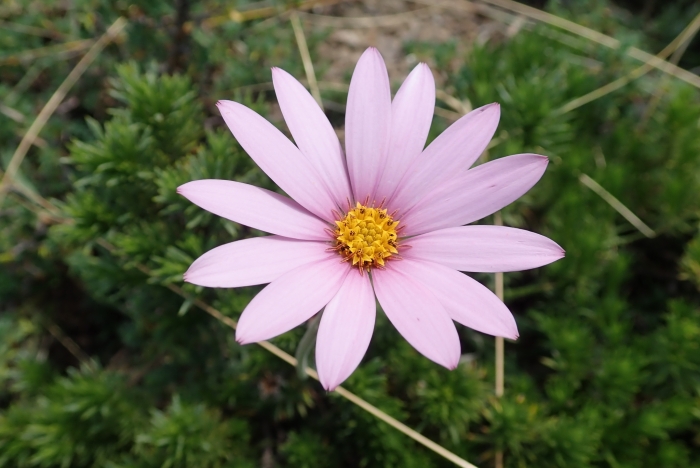Trailing Pink Daisy
(Dimorphotheca jucunda)
Trailing Pink Daisy (Dimorphotheca jucunda)
/
/

Peter Warren
Public Domain
Image By:
Peter Warren
Recorded By:
Copyright:
Public Domain
Copyright Notice:
Photo by: Peter Warren | License Type: Public Domain | License URL: http://creativecommons.org/publicdomain/zero/1.0/ | Rights Holder: Peter Warren | Publisher: iNaturalist | Date Created: 2021-03-15T11:02:41-07:00 |








































Estimated Native Range
Summary
Dimorphotheca jucunda, commonly known as the trailing pink daisy, is a perennial herb native to the Eastern Cape of South Africa, where it thrives in open, sandy plains and rocky outcrops. It typically forms a low, spreading mound up to 12 inches (30 cm) in height and can spread to about 24 inches (60 cm) wide. The trailing pink daisy is characterized by its daisy-like flowers, which are a vibrant pink with a dark center and bloom profusely from late winter to spring, offering a long-lasting display of color. The foliage is green and lance-shaped, adding to the plant’s overall aesthetic appeal.
This plant is valued for its drought tolerance and vibrant floral display, making it an excellent choice for rock gardens, borders, and ground cover in areas with dry climates. It is also suitable for coastal gardens due to its tolerance of salty conditions. The trailing pink daisy requires minimal maintenance once established, making it a favorite among gardeners seeking low-care landscaping options. It is recommended to plant it in a location with full sun exposure to encourage maximum flowering. While it is generally disease-resistant, it can be susceptible to root rot if overwatered or planted in poorly drained soils. To prevent this, ensure good drainage and avoid excessive watering. ’Blackthorn Seedling’ and ’Langtrees’ are popular cultivars known for their robust growth and floriferous nature, having earned the Royal Horticultural Society’s Award of Garden Merit.CC BY-SA 4.0
This plant is valued for its drought tolerance and vibrant floral display, making it an excellent choice for rock gardens, borders, and ground cover in areas with dry climates. It is also suitable for coastal gardens due to its tolerance of salty conditions. The trailing pink daisy requires minimal maintenance once established, making it a favorite among gardeners seeking low-care landscaping options. It is recommended to plant it in a location with full sun exposure to encourage maximum flowering. While it is generally disease-resistant, it can be susceptible to root rot if overwatered or planted in poorly drained soils. To prevent this, ensure good drainage and avoid excessive watering. ’Blackthorn Seedling’ and ’Langtrees’ are popular cultivars known for their robust growth and floriferous nature, having earned the Royal Horticultural Society’s Award of Garden Merit.CC BY-SA 4.0
Plant Description
- Plant Type: Herb
- Height: 1-1.5 feet
- Width: 0.2-0.3 feet
- Growth Rate: Moderate
- Flower Color: Pink, Purple
- Flowering Season: Spring, Summer
- Leaf Retention: Deciduous
Growth Requirements
- Sun: Full Sun
- Water: Low
- Drainage: Medium, Fast
Common Uses
Bee Garden, Border Plant, Drought Tolerant, Fragrant, Groundcover, Low Maintenance, Rock Garden, Salt Tolerant, Showy Flowers
Natural Habitat
Native to open, sandy plains and rocky outcrops in the Eastern Cape of South Africa
Other Names
Common Names: Trailing Mauve Daisy, Osteospermum
Scientific Names: , Osteospermum jucundum, Dimorphotheca jucunda,
GBIF Accepted Name: Dimorphotheca jucunda E.Phillips